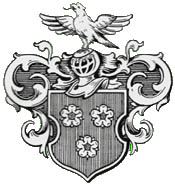| |
| 1500 |
1532 the family of Cord Roosen (1495-1553)
emigrated from the Netherlands to Germany. They were Mennonites and found a new home in
Steinrade by Lübeck. Cord worked as a farmer and produced gunpowder. In 1566, his
youngest son, Geerlinck Roosen (1532-1611), rented the farm "Hof Holzkamp" which
belonged to the "Gute Mori" near Lübeck. |
| |
|
| 1600 |
The son of Geerlink Roosen, Paul Roosen
(1582-27.2.1649), emigrated to the city of Hamburg. He let an artist creadte the
silver plate with the coat of arms. The plate still exists and is
showen in the hamburgian museum of arts and trade. There he founded in 1611 the
"Gerberei" at "die großen Freiheit". In 1619 he owned land north to
the große Roosenstraße. Because of him a street is called "Paul Roosenstraße"
in "St. Pauli". His son Coordt III Roosen (29.2.1629 - 10.3.1688) learned
Leinwandbereitung in Friedrichstadt and trading with his brother Gerritt. When he was
young he made a few journeys with his big brother Herman I Roosen (11.3.1627 - 3.4.1696)
to Germany and Italy. Later on he sold some land to his church to build a new church. The
son of Coordt III Roosen, Johann V Roosen-Runge was the first Roosen-Runge. Since 1856 he
called his family Roosen-Runge because of the trader Johann Runge who took care of him
when his father died early.The youngest Brother of Coordt III Roosen,
Gerrit
Roosen (8.3.1612 - 20.11.1711) was a prayer, wrote several books and helped his chuch
in poor times. He was the one who orderd six silver goblets build fom handcrafts for each
of his children. The silver goblet shows roses as a symbol for
each child Gerrit Roosen had. He is to be seen in the same musseum as the silver plate. |
| |
|
| 1700 |
Berend I Roosen
(11.7.1705 - 3.6.1788) owned the ground at the Vorsetzen and at
he Brauernknechtsgraben, also the Kramersche Shipyard at the Reiherstieg. The
Reiherstiegwerft was the first big shipowner the family owned. Berend
I Roosen lived in the Turmhaus and
build the Roosenbridge.One Sommerhouse,
called Sommersitz der Familie is the Roosen wooden house at
Elbchaussee 388, which exists today. It was built by
Berend III
Roosen (7.5.1757 - 5.4.1820) he also owned 1798 the park in Nienstedten, Elbchaussee
147. In 1772, Salomon I Roosen (7.7.1717 -15.12.1795) owned the
houses at Neuen Wall 82-84. He also had a small farm at Klein Flottbek at Baron Voght
Street 27. Salomon was 1768 Diakon. He is the founder of the NEUEN WALL - branch. Another
famous trader was Berend II Roosen (30.6.1744 - 3.4.1829),
Mennonite and owner of the trading comp. "Paul Kramers Witw & Berend Roosen und
Berend Roosen, Hermans Sohn". He lived in the
Kranichhaus,
next to the Turmhaus in the Vorsetzen 4. Later he lived at Jungfernstieg and owned the
summer house "die Bost" in Dockenhude.
His son Salomon II Roosen owned
Elbchaussee
386. |
|
| 1800 |
The trading family of Berend Paulus Roosen (1792
bis 1875) owned the Roosenspark in Othmarschen. At that time, the
Roosen family owned 99 different Schiffe. His son
Berend Otto Roosen (28.9.1832 - 28.1.1912) lived in
Othmarschen. He was the founder of the OTHMARSCHNER- branch.
Rudolph Roosen (22.10.1830 - 7.1.1909) was senator of the City of
Hamburg. That's why we got our coat of arms in the city hall. Eduard
Roosen owned Elbchaussee 435. |
|
|
| 1900 |
The Roosen family founded a
few
companies. The
time of sailing ships came to an end. |
|
|
| 2000 |
A part of the family lives in Hamburg. Another
part moved to Kassel in Hessen. One family lives near to Aschaffenburg in Bayern. In
Argentina, Paraguay, Brazil, Australia and America there are hundreds more family members. |
|
|
 |
The coat of arms. On the main body you can see
three roses--the symbol of the family. The helmet is a symbol of strength and power. On
the helmet you can see a bird (German=Kranich). He is a symbol of trade, because he is a
bird of passage. In the legend he has an iron ball in his hand. This he should drop on the
trading house to wake up all Roosen traders to improve trading relations. Around the coat
of arms you can see ivy growing. Ivy is an evergreen plant and means that the family's
power and strength will never end! |
|
|